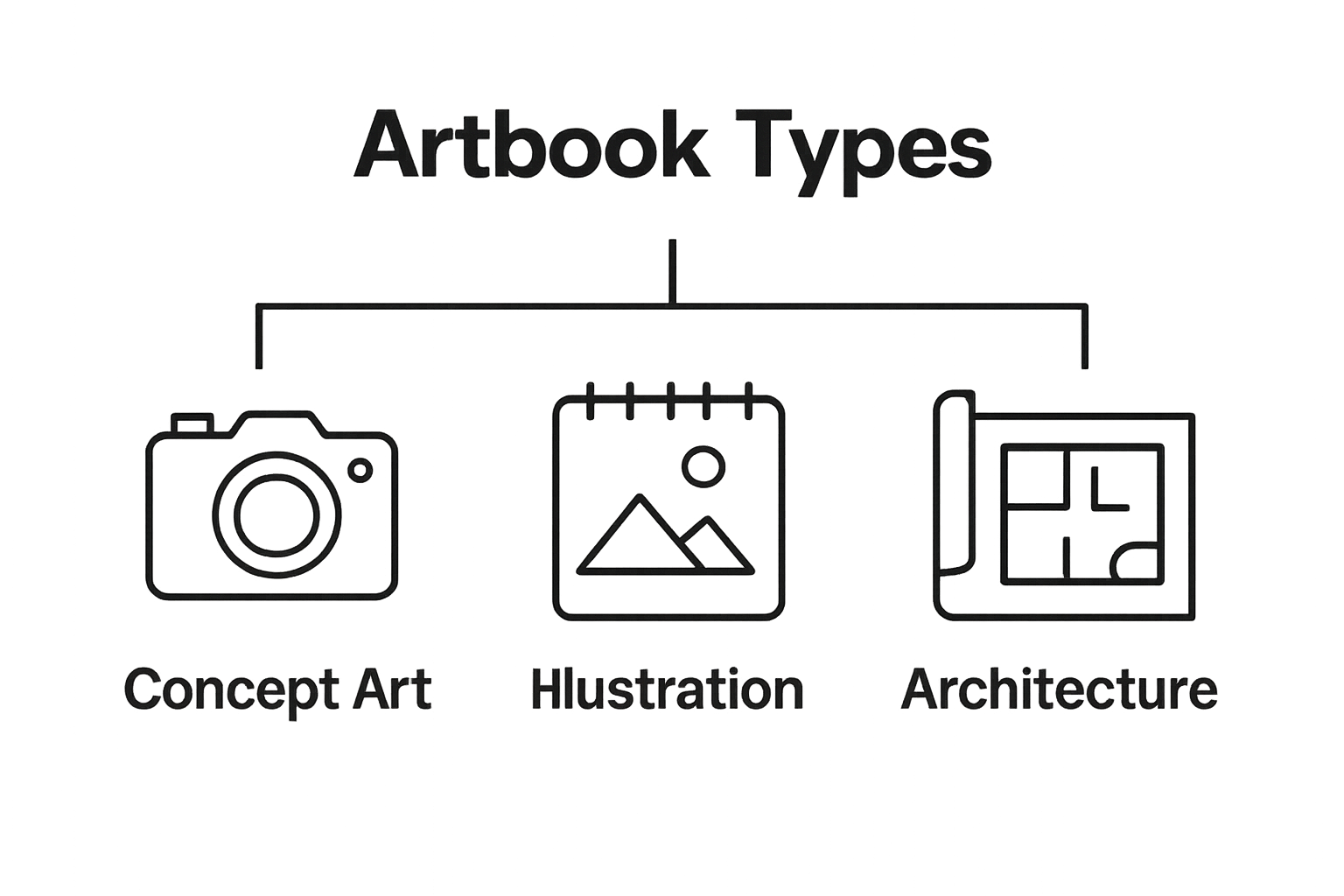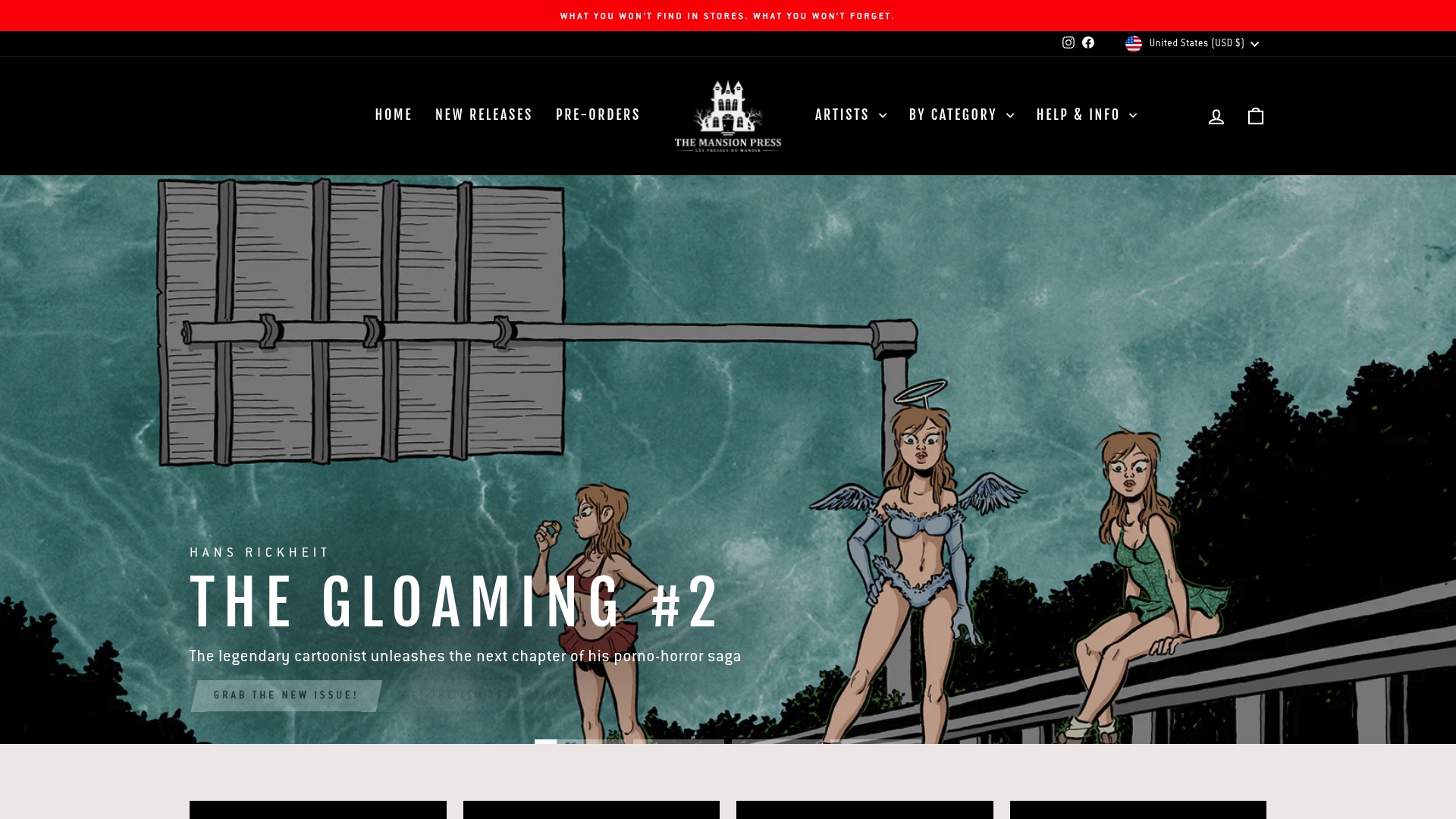What Defines an Artbook? Understanding the Essentials
Artbooks are not just pretty picture collections. They are prized by collectors and artists alike for a good reason. Professional archivists consider artbooks to be essential research tools that offer deep insights into an artist’s progression and technical mastery. Most folks expect them to be just glossy coffee table décor. Turns out, these books hold the stories, sketches, and secrets behind entire creative movements and individual journeys—and sometimes, the only surviving record of an artist’s creative process.
Table of Contents
- The Concept Of An Artbook: A Definition
- The Importance Of Artbooks In The Art World
- Key Elements That Define An Artbook
- Different Types Of Artbooks And Their Purposes
- The Role Of Artbooks In Artistic Expression And Culture
Quick Summary
| Takeaway | Explanation |
|---|---|
| Artbooks are comprehensive visual narratives. | Unlike standard publications, artbooks combine artwork and storytelling, providing deep insights into an artist’s creative journey. |
| High production quality is essential for artbooks. | They utilize premium materials and printing techniques to ensure intricate details and vibrant color reproduction, enhancing viewer experience. |
| Artbooks preserve artistic heritage and techniques. | They function as historical documents, capturing important artistic movements, techniques, and individual artist trajectories for future generations. |
| These publications democratize artistic knowledge. | Artbooks make complex creative processes accessible, bridging gaps between professional artists and the general public while facilitating broader appreciation. |
| Artbooks serve various professional purposes. | They are essential for marketing and networking, allowing artists to showcase their portfolios and establish their professional identities. |
The Concept of an Artbook: A Definition
An artbook represents a specialized publication that transcends traditional print media, offering a comprehensive visual narrative focused on artistic expression and creative documentation. Unlike standard books, artbooks are curated collections that showcase visual artwork, design concepts, and creative processes across various artistic disciplines.
Understanding Core Characteristics
What defines an artbook goes beyond mere image compilation. These publications are carefully crafted visual experiences that provide insight into an artist’s creative journey, aesthetic philosophy, and technical approach. According to the International Artists Association, artbooks serve multiple critical functions in the art world:
- Documenting artistic processes and developmental stages
- Preserving visual narratives and creative concepts
- Providing in-depth exploration of artistic techniques and styles
The primary purpose of an artbook is not just displaying artwork but creating a holistic narrative that connects viewers with the creator’s vision. Professional artists and illustrators use these publications as comprehensive portfolios that demonstrate their range, skill progression, and conceptual thinking.
Distinguishing Features
Production Quality: Artbooks are distinguished by their exceptional print quality, utilizing high-grade paper, advanced printing techniques, and meticulous color reproduction. Research from the Print and Design Institute indicates that premium artbooks often employ specialized printing methods to capture intricate details and nuanced color gradations.
While traditional books prioritize text, artbooks elevate visual content as the primary communication medium.
The following table organizes the distinguishing features that separate artbooks from traditional books, highlighting aspects of production, content, and purpose for clearer comparison.
| Feature | Artbooks | Traditional Books |
|---|---|---|
| Main Focus | Visual content and narrative integration | Textual information and storytelling |
| Production Quality | High-quality paper, advanced printing, color fidelity | Standard printing and materials |
| Content Types | Artwork, sketches, annotations, behind-the-scenes insights | mainly text, with minimal illustrations |
| Purpose | Showcase artistic journey and creative process | Inform, entertain, or educate through written content |
| Intended Audience | Art professionals, collectors, enthusiasts | General readers or targeted subject audiences |
| Documentation Value | Preserves creative process and artistic movements | Documents stories, facts, or information |
| Narrative Structure | Combines images and artist commentary for context | sequential text with occasional visuals |
The scope of artbooks spans numerous creative domains including illustration, concept art, graphic design, animation, photography, and digital art. Each publication represents a unique window into the creator’s world, inviting viewers to explore complex visual narratives and appreciate the intricate processes behind artistic expression.
The Importance of Artbooks in the Art World
Artbooks play a profound role in contemporary artistic discourse, functioning as critical repositories of creative knowledge and cultural documentation beyond traditional exhibition spaces. These publications serve as powerful mediums for preserving artistic narratives, facilitating intellectual exchange, and providing unprecedented access to creative processes that might otherwise remain unseen.
Preserving Artistic Heritage
According to the Global Art Documentation Center, artbooks represent more than aesthetic objects they are historical artifacts that capture the evolution of artistic movements and individual creative journeys. They offer comprehensive documentation of artistic development that museums and galleries cannot always accommodate. Professional archivists recognize artbooks as essential research tools that provide deep insights into an artist’s conceptual progression and technical mastery.
Key contributions of artbooks to artistic preservation include:
- Creating permanent records of ephemeral artistic expressions
- Documenting experimental and emerging artistic techniques
- Providing scholarly resources for art historians and researchers
Cultural and Educational Significance
Beyond preservation, artbooks function as critical educational resources that democratize artistic knowledge. Research from the International Art Education Association demonstrates that these publications enable broader audiences to engage with complex creative processes, breaking down barriers between professional artists and art enthusiasts.
Artbooks bridge academic and popular understanding of artistic practices, offering insights that traditional academic texts often cannot provide. They translate sophisticated artistic concepts into visually compelling narratives that make advanced creative techniques accessible to diverse audiences.
Economic and Professional Impact
In the professional art ecosystem, artbooks serve as powerful marketing and networking tools. Artists use these publications to showcase their portfolio, attract commissions, and establish their professional reputation. For collectors and galleries, artbooks represent valuable documentation of an artist’s portfolio and potential investment opportunities.
The production of an artbook signals an artist’s professional maturity and commitment to their craft.
It demonstrates not just technical skill but also the ability to curate and present one’s artistic vision comprehensively. Through these publications, artists communicate their unique aesthetic philosophy and invite audiences into their creative universe.
Key Elements that Define an Artbook
Defining an artbook involves understanding its unique structural and conceptual components that distinguish it from standard publications. These specialized volumes represent carefully curated visual experiences that combine aesthetic presentation with meaningful artistic narrative.
Visual Composition and Design
According to the International Design Academy, artbooks are distinguished by their meticulous visual architecture. Unlike traditional books, these publications prioritize visual storytelling through deliberate layout, strategic image placement, and sophisticated design principles that transform the book into an artistic medium itself.
Critical design elements that characterize artbooks include:

- Intentional white space management
- Seamless integration of images and text
- Innovative page transitions and visual flow
- High-quality paper selection
- Exceptional color reproduction
Narrative and Contextual Depth
Content complexity sets artbooks apart from conventional image collections. Research from the Visual Arts Documentation Center reveals that successful artbooks provide multilayered storytelling that extends beyond visual representation. They offer comprehensive insights into artistic processes, including preliminary sketches, conceptual development, and creative philosophy.
The narrative structure typically encompasses:
- Behind-the-scenes creative documentation
- Artist commentary and personal reflections
- Technical annotations explaining artistic techniques
- Contextual information about artistic influences
Technical Production Standards
Professional artbooks adhere to rigorous production standards that elevate them from simple image compilations to collectible art objects. Print quality, material selection, and manufacturing precision are paramount in creating publications that serve as both visual archives and aesthetic experiences.
Key technical considerations include specialized printing techniques that capture intricate details, archival-grade materials that ensure long-term preservation, and design approaches that respect the artist’s original vision. These publications represent collaborative efforts between artists, designers, and publishers committed to presenting creative work with exceptional fidelity and reverence.
Different Types of Artbooks and Their Purposes
The artbook landscape encompasses diverse publication types, each serving unique artistic and cultural functions. These specialized volumes reflect the multifaceted nature of creative expression across various disciplines, offering distinct approaches to visual storytelling and documentation.
This table categorizes key types of artbooks discussed in the article, summarizing their main characteristics and intended purposes for reference.
| Artbook Type | Main Characteristics | Primary Purpose |
|---|---|---|
| Concept Art Portfolio | Art for films, games, animation; features development art | Visual development and inspiration |
| Illustration Compilation | Curated art by single or multiple illustrators | Showcase individual or collective styles |
| Character Design Collection | Focus on character creation and iteration | Reference for media and entertainment |
| Architectural/Design Documentation | Blueprints, visual processes of design projects | Archive artistic and technical workflows |
| Photography/Visual Documentary | Photographic works, visual storytelling | Document events, culture, or perspectives |
| Academic/Professional Portfolio | Process documentation, research, annotated artwork | Professional showcasing and study |
| Collector/Edition Artbook | Limited runs, unique designs, rare content | Cultural preservation and art collecting |
Genre-Specific Artbook Varieties
According to the International Visual Arts Archive, artbooks can be categorized into several distinctive genres, each with its own specialized purpose and audience. Professional artists and collectors recognize these variations as critical tools for creative communication.
Major artbook categories include:

- Concept art portfolios for film and animation industries
- Illustration compilations showcasing individual artist styles
- Character design collections from gaming and entertainment sectors
- Architectural and design process documentation
- Photography and visual documentary publications
Professional and Academic Applications
Academic and professional artbooks serve critical documentation functions beyond aesthetic presentation. Research from the Creative Industries Research Center highlights how these publications function as professional development resources, providing comprehensive insights into creative methodologies.
Specialized artbook types in professional contexts include:
- Academic research documentation
- Professional portfolio presentations
- Comprehensive retrospective collections
- Exhibition catalog publications
- Interdisciplinary creative process explorations
Cultural and Collector Significance
Beyond professional applications, artbooks represent significant cultural artifacts that preserve creative legacies. They function as critical documentation mechanisms, allowing audiences to explore artistic movements, individual creative journeys, and complex visual narratives that transcend traditional exhibition formats.
Collector-focused artbooks often represent limited edition publications that combine exceptional design, rare visual content, and intrinsic cultural value. These volumes are not merely books but collectible art objects that capture specific moments in artistic development, offering audiences an intimate window into creative processes and visual storytelling.
The Role of Artbooks in Artistic Expression and Culture
Artbooks function as profound cultural artifacts that extend far beyond simple visual documentation, serving as critical mediums for understanding artistic evolution, creative processes, and the intricate dialogue between artists and their audiences. These publications represent complex narrative platforms that capture the essence of artistic expression in ways traditional media cannot.
Preserving Creative Narratives
According to the Global Cultural Heritage Institute, artbooks play a pivotal role in archiving contemporary artistic movements and individual creative trajectories. They transform ephemeral artistic moments into permanent cultural records, providing scholars, enthusiasts, and future generations with comprehensive insights into creative development.
Key functions in narrative preservation include:
- Documenting emerging artistic techniques
- Capturing experimental creative processes
- Providing contextual understanding of artistic movements
- Archiving visual cultural expressions
- Creating historical records of artistic innovation
Democratizing Artistic Knowledge
Artbooks serve as critical educational tools that break down traditional barriers between professional artists and broader audiences. Research from the International Arts Education Council demonstrates how these publications democratize artistic knowledge, making complex creative processes accessible to diverse populations.
These publications achieve knowledge democratization through:
- Providing detailed visual explanations
- Offering artist commentaries and personal insights
- Presenting technical information in engaging formats
- Bridging academic and popular artistic understanding
- Encouraging broader artistic appreciation
Cultural Dialogue and Representation
Beyond documentation, artbooks function as powerful platforms for cultural dialogue and representation. They provide artists with opportunities to communicate complex narratives, challenge existing artistic paradigms, and explore diverse perspectives through visual storytelling.
By presenting nuanced artistic expressions, these publications contribute to broader cultural conversations, challenge traditional representation methods, and offer audiences intimate windows into creative universes that transcend geographical and cultural boundaries. Artbooks ultimately function as dynamic cultural interfaces that continuously redefine our understanding of artistic expression.
Own the Essence of Artistic Storytelling
Are you inspired by the in-depth exploration of creative journeys and the meticulous curation discussed in our article on what defines an artbook? Many art lovers struggle to find authentic artbooks and collector’s pieces that truly capture an artist’s vision and process, especially those exclusive editions rarely available in traditional shops. The Mansion Press is dedicated to bridging this gap by bringing you expertly curated artbooks and limited editions that embody the artistic narrative and high-quality standards highlighted in the article.

Now is your chance to experience the world of unique visual storytelling firsthand. Discover a handpicked selection of collector’s artbooks, comics, and original artwork straight from creators. Visit The Mansion Press main site to browse our newest arrivals and artist showcases. Connect with artworks you won’t find anywhere else. Start collecting today and elevate your appreciation of artbooks to a whole new level.
Frequently Asked Questions
What is the main purpose of an artbook?
The primary purpose of an artbook is to create a holistic narrative that connects viewers with the creator’s vision, documenting the artistic process and showcasing the artist’s work in a visually compelling way.
How do artbooks differ from traditional books?
Unlike traditional books, artbooks prioritize visual content and storytelling, often including sketches, annotations, and behind-the-scenes insights, making them an immersive experience rather than just a collection of images.
What are the key elements that define an artbook?
Key elements include high production quality, meticulous design and layout, narrative depth, and comprehensive documentation of an artist’s processes and techniques, all contributing to a unique visual experience.
How do artbooks contribute to artistic preservation?
Artbooks serve as critical repositories of artistic knowledge, preserving ephemeral artistic expressions, documenting emerging techniques, and providing resources for art historians and researchers to explore an artist’s creative journey.

